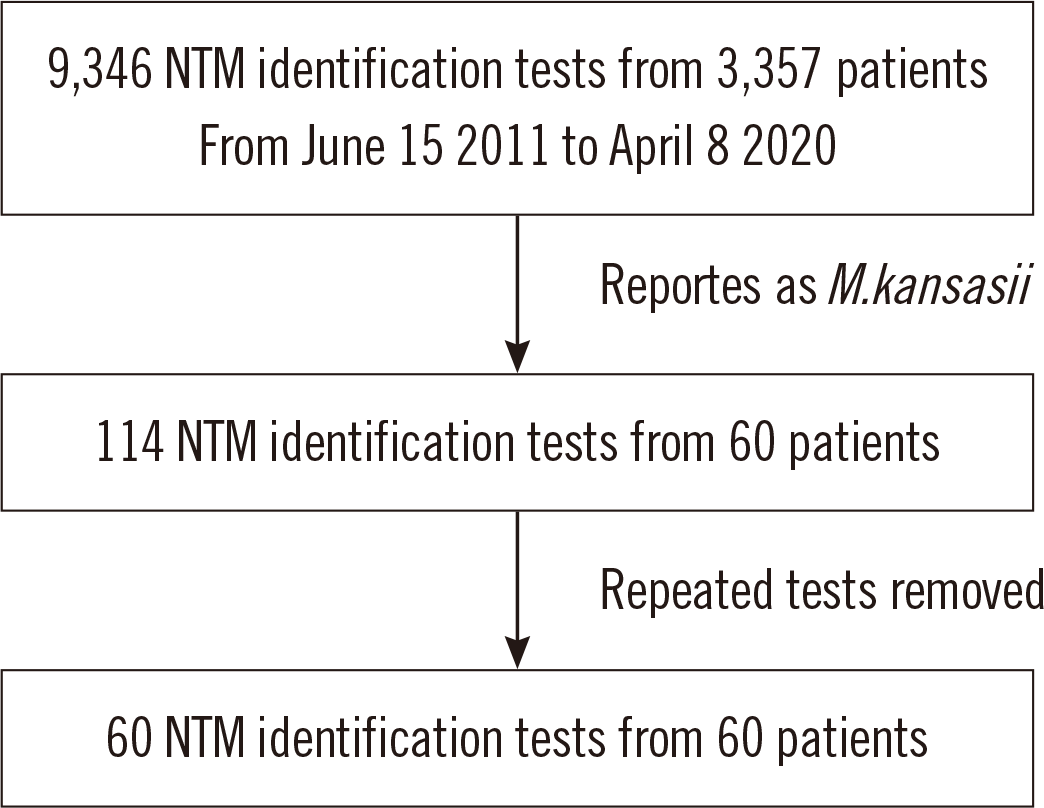1. Koh WJ, Kwon OJ, Jeon K, Kim TS, Lee KS, Park YK, et al. 2006; Clinical significance of nontuberculous mycobacteria isolated from respiratory specimens in Korea. Chest. 129:341–8. DOI:
10.1378/chest.129.2.341. PMID:
16478850.


2. Van Ingen J, Bendien SA, De Lange WC, Hoefsloot W, Dekhuijzen PNR, Boeree MJ, et al. 2009; Clinical relevance of non-tuberculous mycobacteria isolated in the Nijmegen-Arnhem region, The Netherlands. Thorax. 64:502–6. DOI:
10.1136/thx.2008.110957. PMID:
19213773.


3. Matveychuk A, Fuks L, Priess R, Hahim I, Shitrit D. 2012; Clinical and radiological features of
Mycobacterium kansasii and other NTM infections. Respir Med. 106:1472–7. DOI:
10.1016/j.rmed.2012.06.023. PMID:
22850110.

4. Jagielski T, Borówka P, Bakuła Z, Lach J, Marciniak B, Brzostek A, et al. 2020; Genomic insights into the
Mycobacterium kansasii complex: an update. Front Microbiol. 10:2918. DOI:
10.3389/fmicb.2019.02918. PMID:
32010067. PMCID:
PMC6974680.


5. Alcaide F, Richter I, Bernasconi C, Springer B, Hagenau C, Schulze-Röbbecke R, et al. 1997; Heterogeneity and clonality among isolates of
Mycobacterium kansasii: implications for epidemiological and pathogenicity studies. J Clin Microbiol. 35:1959–64. DOI:
10.1128/JCM.35.8.1959-1964.1997. PMID:
9230363. PMCID:
PMC229884.


6. Picardeau M, Prod'Hom G, Raskine L, LePennec MP, Vincent V. 1997; Genotypic characterization of five subspecies of
Mycobacterium kansasii. J Clin Microbiol. 35:25–32. DOI:
10.1128/JCM.35.1.25-32.1997. PMID:
8968876. PMCID:
PMC229507.


7. Taillard C, Greub G, Weber R, Pfyffer GE, Bodmer T, Zimmerli S, et al. 2003; Clinical implications of
Mycobacterium kansasii species heterogeneity: Swiss National Survey. J Clin Microbiol. 41:1240–4. DOI:
10.1128/JCM.41.3.1240-1244.2003. PMID:
12624057. PMCID:
PMC150277.


8. Kim BJ, Lee KH, Park BN, Kim SJ, Bai GH, Kim SJ, et al. 2001; Differentiation of mycobacterial species by PCR-restriction analysis of DNA (342 base pairs) of the RNA polymerase gene (rpoB). J Clin Microbiol. 39:2102–9. DOI:
10.1128/JCM.39.6.2102-2109.2001. PMID:
11376042. PMCID:
PMC88096.



9. Bakuła Z, Modrzejewska M, Safianowska A, van Ingen J, Proboszcz M, Bielecki J, et al. 2016; Proposal of a new method for subtyping of
Mycobacterium kansasii based upon PCR restriction enzyme analysis of the
tuf gene. Diagn Microbiol Infect Dis. 84:318–21. DOI:
10.1016/j.diagmicrobio.2015.12.009. PMID:
26830053.

10. Zhang Y, Mann LB, Wilson RW, Brown-Elliott BA, Vincent V, Iinuma Y, et al. 2004; Molecular analysis of
Mycobacterium kansasii isolates from the United States. J Clin Microbiol. 42:119–25. DOI:
10.1128/JCM.42.1.119-125.2004. PMID:
14715741. PMCID:
PMC321655.


11. da Silva Telles MA, Chimara E, Ferrazoli L, Riley LW. 2005;
Mycobacterium kansasii: antibiotic susceptibility and PCR-restriction analysis of clinical isolates. J Med Microbiol. 54:975–9. DOI:
10.1099/jmm.0.45965-0. PMID:
16157553.

12. Bakuła Z, Modrzejewska M, Pennings L, Proboszcz M, Safianowska A, Bielecki J, et al. 2018; Drug susceptibility profiling and genetic determinants of drug resistance in
Mycobacterium kansasii. Antimicrob Agents Chemother. 62:e01788–17. DOI:
10.1128/AAC.01788-17. PMID:
29437627. PMCID:
PMC5913922.
13. Guan Q, Ummels R, Ben-Rached F, Alzahid Y, Amini MS, Adroub SA, et al. 2020; Comparative genomic and transcriptomic analyses of
Mycobacterium kansasii subtypes provide new insights into their pathogenicity and taxonomy. Front Cell Infect Microbiol. 10:122. DOI:
10.3389/fcimb.2020.00122. PMID:
32266172. PMCID:
PMC7105574.



14. Li Y, Pang Y, Tong X, Zheng H, Zhao Y, Wang C. 2016;
Mycobacterium kansasii Subtype I is associated with clarithromycin resistance in China. Front Microbiol. 7:2097. DOI:
10.3389/fmicb.2016.02097. PMID:
28082964. PMCID:
PMC5184217.



15. Shahraki AH, Trovato A, Mirsaeidi M, Borroni E, Heidarieh P, Hashemzadeh M, et al. 2017;
Mycobacterium persicum sp. nov., a novel species closely related to
Mycobacterium kansasii and
Mycobacterium gastri. Int J Syst Evol Microbiol. 67:1766–70. DOI:
10.1099/ijsem.0.001862. PMID:
28629501.

16. Tagini F, Aeby S, Bertelli C, Droz S, Casanova C, Prod'Hom G, et al. 2019; Phylogenomics reveal that
Mycobacterium kansasii subtypes are species-level lineages. Description of
Mycobacterium pseudokansasii sp. nov.,
Mycobacterium innocens sp. nov. and
Mycobacterium attenuatum sp. nov. Int J Syst Evol Microbiol. 69:1696–704. DOI:
10.1099/ijsem.0.003378. PMID:
30950782.

17. Parker CT, Tindall BJ, Garrity GM. 2019; International code of nomenclature of prokaryotes: prokaryotic code. Int J Syst Evol Microbiol. 69:S1–111. DOI:
10.1099/ijsem.0.000778. PMID:
26596770.
18. CLSI. 2018. Laboratory detection and identification of mycobacteria. CLSI M48. 2nd ed. Clinical and Laboratory Standards Institute;Wayne, PA:
19. Park HK, Koh WJ, Shim TS, Kwon OJ. 2010; Clinical characteristics and treatment outcomes of
Mycobacterium kansasii lung disease in Korea. Yonsei Med J. 51:552–6. DOI:
10.3349/ymj.2010.51.4.552. PMID:
20499421. PMCID:
PMC2880268.


20. Moon SM, Park HY, Jeon K, Kim SY, Chung MJ, Huh HJ, et al. 2015; Clinical significance of
Mycobacterium kansasii isolates from respiratory specimens. PLoS One. 10:e0139621. DOI:
10.1371/journal.pone.0139621. PMID:
26431540. PMCID:
PMC4592008.
21. Bloch KC, Zwerling L, Pletcher MJ, Hahn JA, Gerberding JL, Ostroff SM, et al. 1998; Incidence and clinical implications of isolation of
Mycobacterium kansasii: results of a 5-year, population-based study. Ann Intern Med. 129:698–704. DOI:
10.7326/0003-4819-129-9-199811010-00004. PMID:
9841601.

22. Shitrit D, Baum GL, Priess R, Lavy A, Shitrit AB-G, Raz M, et al. 2006; Pulmonary
Mycobacterium kansasii infection in Israel, 1999-2004:clinical features, drug susceptibility, and outcome. Chest. 129:698–704. DOI:
10.1378/chest.129.3.771. PMID:
16537880.
23. Bodle EE, Cunningham JA, Della-Latta P, Schluger NW, Saiman L. 2008; Epidemiology of nontuberculous mycobacteria in patients without HIV infection, New York City. Emerg Infect Dis. 14:390–6. DOI:
10.3201/eid1403.061143. PMID:
18325252. PMCID:
PMC2570812.



24. Simons S, van Ingen J, Hsueh PR, Van Hung N, Dekhuijzen PN, Boeree MJ, et al. 2011; Nontuberculous mycobacteria in respiratory tract infections, Eastern Asia. Emerg Infect Dis. 17:343–9. DOI:
10.3201/eid170310060. PMID:
21392422. PMCID:
PMC3165997.



25. CLSI. 2011. Susceptibility testing of mycobacteria, nocardiae, and other aerobic actinomycetes. CLSI M24-A2. Clinical and Laboratory Standards Institute;Wayne, PA: PMID:
31339680.




 PDF
PDF Citation
Citation Print
Print




 XML Download
XML Download